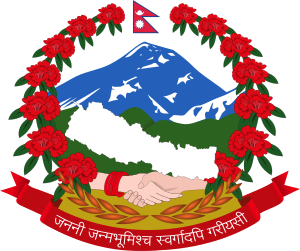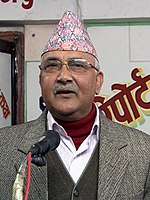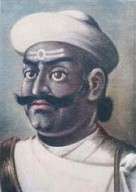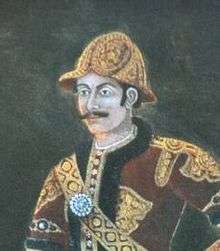Politics of Nepal
The politics of Nepal functions within the framework of a parliamentary republic with a multi-party system.[1] Executive power is exercised by the Prime Minister and his/her cabinet, while legislative power is vested in the Parliament.
 |
|---|
| This article is part of a series on the politics and government of Nepal |
Executive:
Federal Parliament:
Judiciary: |
|
Administrative divisions
|
|
|
|
Related topics |
|
|
It has three political parties mainly recognised in the federal parliament: Nepal Communist Party (NCP), Nepali Congress (NC),[1] and Janata Samajwadi Party (JSPN).[1] While all major parties officially espouse democratic socialism, NCP is considered leftist while Nepali Congress is considered centrist, with most considering it center-left and some center-right.[2] The party JSPN is center-left to left-wing.[3] During most of the brief periods of democratic exercise in the 1950s as well as the 1990s, Nepali Congress held a majority in parliament.[4] Following the entry of the Maoists into the political process, they were the largest party in the first constituent assembly and Nepali Congress was the largest in the second, with no party winning a majority.[5] In second constituent assembly Nepali Congress stood first without winning a majority. In the aftermath of the 2017 elections, the first one according to the new constitution, NCP has become the ruling party at the federal level as well as six out of seven provinces.[6] While Nepali Congress has a significantly reduced representation, it is the only major opposition to the ruling communist party in all levels of government.[7]
The Economist Intelligence Unit rated Nepal a "hybrid regime" in 2019,[8]while the polity data series considers it to be a democracy.[9]
History
Family politics
The four noble families to be involved in the active politics of the Kingdom of Nepal, along with the Shah dynasty, were the Basnyat family, the Pande dynasty and Thapa dynasty before the rise of the Rana dynasty.[13] At the end of 18th century, Thapas and Pandes had extreme dominance over Nepalese Darbar politics alternatively contesting for central power with one another.[14] Early politics in the Kingdom of Nepal was characterised by factionalism, conspiracies and murders, including two major massacres.[lower-alpha 1] After almost a century of power-wrangling among the prominent Basnyat, Pande and Thapa families, a fast-rising military leader Bir Narsingh Kunwar[lower-alpha 2] emerged on top in the aftermath of the Kot massacre, and established the Rana autocratic regime which consolidated powers of the King as well as prime minister and reigned for another century, with a policy of oppression and isolationism.[15][16]
Post 1950s

By the 1930s, Nepali expatriates in India had started smuggling in writings on political philosophies, which gave birth to a vibrant underground political movement in the capital, birthing Nepal Praja Parishad in 1939, which was dissolved only two years later, following the execution of the four great martyrs. Around the same time, Nepalis involved in the Indian Independence Movement started organising into political parties, leading to the birth of Nepali Congress and Communist Party of Nepal. Following Indian Independence, Nepali Congress was successful in overthrowing the Rana regime with support from the Indian government and cooperation from the king.[17] While communism was still trying to find its footing, Nepali Congress enjoyed overwhelming support of the electorate. Following a brief ten-year exercise in democracy, another partyless autocracy was initiated, this time by the King, who deposed the democratically elected government of Nepali Congress, imposed or exiled prominent leaders and issued a ban on party politics.[17][18][19][4]
Many political parties and their leaders remained underground or in exile for the next 30 years of partyless politics in Nepal.[20] BP Koirala was released from prison in 1968 and went into exile in Benaras, returning in 1976 only to immediately be put in house arrest.[17] Although an armed insurgency launched by the major communist faction called the Jhapa movement had failed comprehensively by 1971, it formed the foundation for the dominant communist power, CPN ML, that was officially launched in 1978.[21] A general referendum was held in 1980, which saw the CPN ML campaign for the option of multi-party democracy, along with Nepali Congress, but the Panchayat System was declared the winner to significant controversy.[19] The Panchayat rule saw governments led by a group of monarchy loyalists taking turns, with Surya Bahadur Thapa, Tulsi Giri and Kirti Nidhi Bista becoming prime minister three times each, among others. It introduced a number of reforms, built infrastructures and modernised the country, while significantly curtailing political freedom, imposing the Nepali language and khas culture to the oppression of all others, and spreading Indophobic propaganda the effects of which are experienced to the present day.[17][4]
In 1990, the joint civil resistance launched by the United left front and Nepali Congress was successful in overthrowing the Panchayat, and the country became a constitutional monarchy.[17][22] The United Left Front became CPN UML.[4] The Panchayat loyalists formed National Democratic Party which emerged as the third major party. While Nepali Congress ran the government for most of the next ten years of democracy that followed, democracy was mostly a disappointment owing to the immature democratic culture and political infighting in the capital, as well as the civil war that followed the guerrilla insurgency launched by the Maoist Party. Following a four-year autocratic rule by King Gyanendra that failed to defeat the Maoists, a mass civil protest was launched by a coalition of the maoists and the political parties in 2006, which forced the king to stepped down, brought the maoists to the peace process, and established a democratic republic by 2008.[23][24]

Following the political consensus to draft the new constitution of the Republic via a constituent assembly, Nepali politics saw a rise of nationalist groups and ideologies. While the political power-wrangling caused continuous instability, maintaining the established average of nine months per government, this period saw two constituent assembly elections and the rise of Madhesi nationalist parties, especially in the Eastern Terai region.[5][25][26][27] By 2015, the new constitution had been promulgated and Nepal became "a federal democratic republic striving towards democratic socialism".[28] In 2017, a series of elections were held according to the new constitution, which established Nepal Communist Party (NCP) (formally united after the election) as the ruling party at the federal level as well as six of the seven provinces, Nepali Congress as the only significant opposition in federal and provincial levels, while the Madhesi coalition formed the provincial government in Province No. 2, but boasts negligible presence in the rest of the country.[29][30][31]
Political conditions
2001: Royal massacre
The Royal Massacre (राजदरबार हत्याकाण्ड) happened on 1 June 2001, in which members of the royal family, King Birendra, Queen Aishwarya, Crown Prince Dipendra, Prince Nirajan, as well as many others, were killed in the massacre. However, after the massacre, the Crown Prince survived for a short while in a coma.
Although the prince never regained consciousness before dying, Crown Prince Dipendra was the monarch under the law of Nepali royal succession. Two days later after his death, the late King's surviving brother Gyanendra was proclaimed as a king.
2002–2007: Suspension of parliament and Loktantra Andolan
On 1 February 2002 King Gyanendra suspended the Parliament, appointed a government led by himself, and enforced martial law. The King argued that civil politicians were unfit to handle the Maoist insurgency. Telephone lines were cut and several high-profile political leaders were detained. Other opposition leaders fled to India and regrouped there. A broad coalition called the Seven Party Alliance (SPA) was formed in opposition to the royal takeover, encompassing the seven parliamentary parties who held about 90% of the seats in the old, dissolved parliament.
The UN-OHCHR, in response to events in Nepal, set up a monitoring program in 2005 to assess and observe the human rights situation there[32]
On 22 November 2005, the Seven Party Alliance (SPA) of parliamentary parties and the Communist Party of Nepal (Maoist) agreed on a historic and unprecedented 12-point memorandum of understanding (MOU) for peace and democracy. Nepali people from various walks of life and the international community regarded the MOU as an appropriate political response to the crisis that was developing in Nepal. Against the backdrop of the historical sufferings of the Nepali people and the enormous human cost of the last ten years of violent conflict, the MOU, which proposes a peaceful transition through an elected constituent assembly, created an acceptable formula for a united movement for democracy. As per the 12-point MOU, the SPA called for a protest movement, and the Communist Party of Nepal (Maoist) supported it. This led to a countrywide uprising called the Loktantra Andolan that started in April 2006. All political forces including civil society and professional organisations actively galvanised the people. This resulted in massive and spontaneous demonstrations and rallies held across Nepal against King Gyanendra's autocratic rule.
On 21 April 2006, King Gyanendra declared that "power would be returned to the people". This had little effect on the people, who continued to occupy the streets of Kathmandu and other towns, openly defying the daytime curfew. Finally, King Gyanendra announced the reinstatement of the House of Representatives, thereby conceding one of the major demands of the SPA, at midnight on 24 April 2006. Following this action, the coalition of political forces decided to call off the protests.
At least 14 died during the 19 days of protests.[33]
On 19 May 2006, the parliament assumed total legislative power and gave executive power to the Government of Nepal (previously known as His Majesty's Government). Names of many institutions (including the army) were stripped of the "royal" adjective and the Raj Parishad (a council of the King's advisers) was abolished, with his duties assigned to the Parliament itself. The activities of the King became subject to parliamentary scrutiny and the King's properties were subjected to taxation. Moreover, Nepal was declared a secular state abrogating the previous status of a Hindu Kingdom. However, most of the changes have, as yet, not been implemented. On 19 July 2006, the prime minister, G. P. Koirala, sent a letter to the United Nations announcing the intention of the Nepali government to hold elections to a constituent assembly by April 2007.
December 2007 to May 2008: Abolition of the monarchy
On 23 December 2007, an agreement was made for the monarchy to be abolished and the country to become a federal republic with the Prime Minister becoming head of state.[34] The Communist Party of Nepal (Maoist) became the largest party amidst a general atmosphere of fear and intimidation from all sides.[35] A federal republic was established in May 2008, with only four members of the 601-seat Constituent Assembly voting against the change,[36] which ended 240 years of royal rule in Nepal. The government announced a public holiday for three days, (28 – 30 May), to celebrate the country becoming a federal republic.
Since 2008
Major parties such as the Unified Communist Party of Nepal (Maoist), Communist Party of Nepal (Unified Marxist-Leninist) (CPN UML) and the Nepali Congress agreed to write a constitution to replace the interim constitution[37] within 2 years.
The Maoists, as the largest party of the country, took power right after the elections and named Pushpa Kamal Dahal (Prachanda) as the Prime Minister of Nepal. CPN UML also joined this government, but the Nepali Congress took the part of the main opposition party. Prachanda soon fell into a dispute with the then army chief Rookmanda Katwal and decided to sack him. But the President Ram Baran Yadav, as the supreme head of military power in the country, revoked this decision and gave the army chief additional time in office. An angry Prachanda and his party quit the government, majorly citing this reason and decided to operate as the main opposition to the government headed by CPN UML and its co-partner Nepali Congress afterward. Madhav Kumar Nepal was named the Prime Minister.
The Maoists demanded civilian supremacy over the army.
The Maoists forced closures – commonly known as bandhs – in the country, and also declared autonomous states for almost all the ethnic groups in Nepal.
On May 2012 the constitutional assembly was dissolved and another election to select the new constitutional assembly members were declared by Dr. Baburam Bhattarai.
Madhes Movement (2007–2016)
The Madhes Movement[38] (Nepali: मधेस अान्दोलन) is a political movement launched by various political parties, especially those based in Madhes, for equal rights, dignity and identity of Madhesis and Tharus, Muslims and Janjati groups in Nepal. In nearly a decade, Nepal witnessed three Madhes Movements[39][40] - the first Madhes Movement erupted in 2007,[41] the second Madhes Movement in 2008[42] and the third Madhes Movement in 2015. About the origin of the first Madhes Movement, Journalist Amarendra Yadav writes in The Rising Nepal[43]"When the then seven-party alliance of the mainstream political parties and the CPN-Maoist jointly announced the Interim Constitution in 2007, it totally ignored the concept of federalism, the most desired political agenda of Madhesis and other marginalised communities. A day after the promulgation of the interim statute, a group of Madhesi activists under the Upendra Yadav-led Madhesi Janaadhikar Forum-Nepal (then a socio-intellectual NGO) burnt copies of the interim constitution at Maitighar Mandala, Kathmandu." This triggered the Madhes movement I.
The second Madhes Movement took place in 2008, jointly launched by Madhesi Janaadhikar Forum-Nepal, Terai Madhes Loktantrik Party and Sadbhawana Party led by Rajendra Mahato with three key agenda: federalism, proportional representation and population-based election constituency, which were later ensured in the Interim Constitution of Nepal 2008.
However, The Constitution of Nepal 2015 backtracked from those issues, that were already ensured by the Interim Constitution of Nepal 2008. Supreme Court of Nepal Advocate Dipendra Jha writes in The Kathmandu Post: "many other aspects of the new constitution are more regressive than the Interim Constitution of Nepal 2007. Out of all its deficiencies, the most notable one concerns the issue proportional representation or inclusion in all organs of the state."[44] This triggered the third Madhes Movement by Madhesis[45][46][47] in Nepal. Although the first amendment to the constitution was done, the resistance over the document by Madhesi and Tharus in Nepal still continues.[48][49]
Legislative branch
Pre-2006
From 1991 to 2002 the Parliament (Sansad) had two chambers. The House of Representatives (Pratinidhi Sabha) had 205 members elected for five-year term in single-seat constituencies. The National Council (Rashtriya Sabha) had 60 members, 35 members elected by the Pratinidhi Sabha, 15 representatives of Regional Development Areas and 10 members appointed by the king. Parliament was subsequently dissolved by the king in 2002 on the pretext that it was incapable of handling the Maoist rebels.
From Loktantra Andolan to the Constituent Assembly
After the victory of Loktantra Andolan in the spring of 2006, a unicameral interim legislature replaced the previous parliament. The new body consists both of members of the old parliament as well as nominated members. As of December 2007, the legislature had the following composition.[50]
| Party | Seats |
|---|---|
| Nepali Congress | 133 |
| Unified Communist Party of Nepal (Maoist) | 84 |
| Communist Party of Nepal (Unified Marxist-Leninist) | 83 |
| Rashtriya Prajatantra Party | 9 |
| Nepal Sadbhavana Party (Anandi Devi) | 5 |
| Janamorcha Nepal | 4 |
| Nepal Workers Peasants Party | 4 |
| Rashtriya Jana Morcha | 3 |
| United Left Front | 2 |
| Communist Party of Nepal (Unified) | 2 |
| Rashtriya Janashakti Party | 1 |
The first elections after becoming a Republic: the Constituent Assembly
In May 2008 the elections for the Constituent Assembly saw the Communist Party of Nepal as the largest party in the Constituent Assembly, which will have a term of two years.
| Party | Seats |
|---|---|
| Unified Communist Party of Nepal (Maoist) | 220 |
| Nepali Congress | 110 |
| Communist Party of Nepal (Unified Marxist-Leninist) | 103 |
| Madeshi Jana Adhikar Forum Nepal | 52 |
| Tarai-Madhesh Loktantrik Party | 20 |
| Sadbhavana Party | 9 |
| Rashtriya Prajatantra Party | 8 |
| Communist Party of Nepal (Marxist-Leninist) | 8 |
| Janamorcha Nepal | 7 |
| Communist Party of Nepal (United) | 5 |
| Rastriya Prajatantra Party Nepal | 4 |
| Rastriya Janamorcha | 4 |
| Nepal Workers Peasants Party | 4 |
| Rastriya Janshakti Party | 3 |
| Sanghiya Loktantrik Rastriya Manch | 2 |
| Nepal Sadbhavana Party (Anandidevi) | 2 |
| Rastriya Janamukti Party | 2 |
| Nepali Janata Dal | 2 |
| Communist Party of Nepal (Unified) | 2 |
| Dalit Janajati Party | 1 |
| Nepa Rastriya Party | 1 |
| Samajbadi Prajatantrik Janata Party, Nepal | 1 |
| Chure Bhawar Rastriya Ekta Party, Nepal | 1 |
| Nepal Loktantrik Samajbadi Dal | 1 |
| Nepal Parivar Dal | 1 |
| Independents | 2 |
| Not yet determined | 26 |
Judicial branch
The judiciary is composed of the Supreme Court (सर्बोच्च अदालत), Appellate courts, and various District courts. The Chief Justice of the Supreme Court was appointed by the monarch on the recommendation of the Constitutional Council; the other judges were appointed by the monarch on the recommendation of the Judicial Council.
Nepal's judiciary is legally separate from the executive and legislative and has increasingly shown the will to be independent of political influence. The judiciary has the right of judicial review under the constitution.
International organisation participation of Nepal
AsDB, MINA, CCC, Colombo Plan, ESCAP, FAO, Group of 77, IBRD, ICAO, ICFTU, ICRM, International Development Association, IFAD, International Finance Corporation, IFRCS, International Labour Organization, International Monetary Fund, International Maritime Organization, Intelsat, Interpol, IOC, IOM, International Organization for Standardization (correspondent), ITU, MONUC, Non-Aligned Movement, OPCW, SAARC, United Nations, UNCTAD, UNDP, UNESCO, UNIDO, UNIFIL, UNMIBH, UNMIK, UNMOP, UNMOT, UNTAET, UPU, World Federation of Trade Unions, WHO, WIPO, WMO, WToO, WTrO CPC Nepal (applicant)
Notes
- See Kot massacre and Bhandarkhal massacre
- later known as Janga Bahadur Rana
References
- "Nepal elections explained", Al Jazeera, archived from the original on 14 August 2019, retrieved 17 August 2019
- "Is Nepal headed towards a communist state?", Al Jazeera, archived from the original on 26 July 2019, retrieved 17 August 2019
- "Political polarisation in Nepal ahead of major elections", Zee News, 5 October 2017, archived from the original on 17 August 2019, retrieved 17 August 2019
- Khadka, Narayan (1993), "Democracy and Development in Nepal: Prospects and Challenges", Pacific Affairs, 66 (1): 44–71, doi:10.2307/2760015, ISSN 0030-851X, JSTOR 2760015
- Kaphle, Anup (7 July 2010), "Long stalemate after Maoist victory disrupts life in Nepal", The Washington Post, archived from the original on 4 November 2016, retrieved 22 August 2017
- "NCP to announce party department chiefs today", The Himalayan Times, 21 July 2019, archived from the original on 18 August 2019, retrieved 18 August 2019
- "The Rising Nepal: Nepali Congress in the Opposition", The Rising Nepal, archived from the original on 18 August 2019, retrieved 18 August 2019
- The Economist Intelligence Unit (8 January 2019). "Democracy Index 2019". Economist Intelligence Unit. Retrieved 13 January 2019.
- "Polity IV Country Report 2010: Nepal" (PDF). The Center for Systemic Peace. 2010.
- Nepal:The Struggle for Power (Sourced to U.S. Library of Congress)
- The Bloodstained Throne Struggles for Power in Nepal (1775-1914) - Baburam Acharya
- Karmacharya 2005, p. 88.
- Joshi & Rose 1966, p. 23.
- Pradhan 2012, p. 9.
- "The misunderstood queen", The Kathmandu Post, archived from the original on 21 August 2019, retrieved 21 August 2019
- Basnyat, Prem Singh, "War changed everything", Republica, archived from the original on 21 August 2019, retrieved 21 August 2019
- Ramachandran, Shastri; Ramachandaran, Shastri (2003), "Nepal as Seen from India", India International Centre Quarterly, 30 (2): 81–98, ISSN 0376-9771, JSTOR 23006108
- Adhikari, Dipendra, "Recalling Pushpa Lal", Republica, archived from the original on 26 July 2019, retrieved 17 August 2019
- M. D. Gurung (1977), "Communist Movement in Nepal", Economic and Political Weekly, 12 (44): 1849–1852, JSTOR 4366057
- P, Ashok R.; January 30, ey; May 15, 2014 ISSUE DATE; November 24, 1980UPDATED; Ist, 2014 16:07, "Panchayat system or multiparty system of govt: Nepal in throes of political crisis", India Today, archived from the original on 21 August 2019, retrieved 21 August 2019CS1 maint: numeric names: authors list (link)
- "Nepali Times | The Brief » Blog Archive » RK Mainali rejoins UML", Nepali Times, archived from the original on 21 November 2015, retrieved 26 July 2019
- Rawal, Bhim Bahadur. Nepalma samyabadi andolan: udbhab ra vikas. Kathmandu: Pairavi Prakashan. p. 83-84.
- Bell, Thomas (28 May 2008), "Nepal abolishes monarchy as King Gyanendra given fortnight to vacate palace", The Daily Telegraph, archived from the original on 16 April 2018, retrieved 5 April 2018
- "Is Nepal headed towards a communist state?", Al Jazeera, archived from the original on 26 July 2019, retrieved 26 July 2019
- "Nepal's election The Maoists triumph", The Economist, 17 April 2008, archived from the original on 29 July 2011, retrieved 29 July 2009
- "Baburam Bhattarai elected prime minister of Nepal", BBC News, 28 August 2011, archived from the original on 10 October 2011, retrieved 12 March 2012
- "Nepal PM calls new elections after constitution failure", CBC News, 28 May 2012, archived from the original on 28 May 2012, retrieved 28 May 2012
- "Nepal's new constitution endorsed through Constituent Assembly — Xinhua | English.news.cn", Xinhua News Agency, archived from the original on 30 November 2015, retrieved 26 June 2017
- "UML wins mayor, deputy mayor in Pokhara Lekhnath metropolis", The Kathmandu Post, archived from the original on 18 April 2018, retrieved 18 April 2018
- "Nepali Communists win landslide, but face big obstacles to win change", Green Left Weekly, 5 January 2018, archived from the original on 26 July 2019, retrieved 17 August 2019
- "UML to get 4 chief ministers, Maoist Centre 2", The Kathmandu Post, archived from the original on 18 April 2018, retrieved 18 April 2018
- Nepal Summary Archived 17 July 2007 at the Wayback Machine, OHCHR.
- Gurubacharya, Binaj (24 December 2007). "Nepal to Abolish Monarchy". Time. Archived from the original on 25 December 2007. Retrieved 26 December 2007.
- "The Maoists triumph". The Economist. 17 April 2008.
- Nepal votes to abolish monarchy BBC News, 28 May 2008
- "Madhes movement - The Himalayan Times". The Himalayan Times. Retrieved 21 October 2017.
- "Madhesh Movement: Then n now (Part I of III) – OnlineKhabar". english.onlinekhabar.com. Retrieved 21 October 2017.
- "Madhesh Movement: Then n now (Part II of III) – OnlineKhabar". english.onlinekhabar.com. Retrieved 21 October 2017.
- "Three years later - Nepali Times". nepalitimes.com. Retrieved 21 October 2017.
- "Three years later - Nepali Times". nepalitimes.com. Retrieved 21 October 2017.
- "The Rising Nepal: Ten Years On, Madhes Still In Unrest". therisingnepal.org.np. Retrieved 21 October 2017.
- "Talk to the Tarai". Retrieved 21 October 2017.
- "Who are the Madhesis, why are they angry?". The Indian Express. 5 October 2015. Retrieved 21 October 2017.
- Sharma, Bhadra; Najar, Nida (28 September 2015). "Nepal Rations Fuel as Political Crisis With India Worsens". The New York Times. ISSN 0362-4331. Retrieved 21 October 2017.
- "The Secret to Resolving Madhes Andolan III Demands - Madhesi Youth". Madhesi Youth. 24 November 2015. Retrieved 21 October 2017.
- Yadav, Anumeha. "Interview: 'For Madhesis, the first amendments to Nepal's new Constitution are a disappointment'". Scroll.in. Retrieved 21 October 2017.
- "THRD Alliance Resistance Continues as Nepal Observes the 2nd Anniversary of Constitution Promulgation - THRD Alliance". thrda.org. Retrieved 21 October 2017.
- "Interim parliament endorses Interim Constitution-2063". NepalNews.com. 15 January 2007. Retrieved 26 December 2007.
Further reading
Jonathan Devendra. 2013. Massacre at the Palace: The Doomed Royal Dynasty of Nepal. New York: Hyperion. ISBN 0-7868-6878-3.
External links
- The Interim Constitution of Nepal, 2063 (2007)
- The Constitution of The Kingdom of Nepal, 2047 (1990) (terminated by the Interim Constitution)

